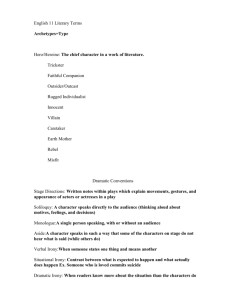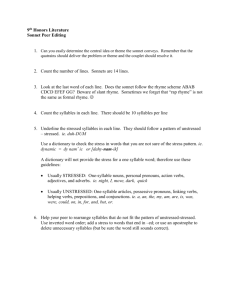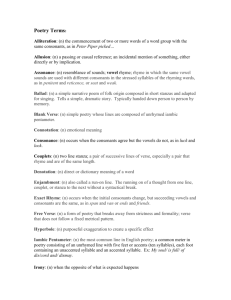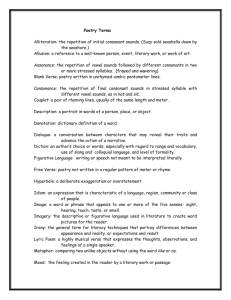Literary Terms - Clinton Public School District
advertisement
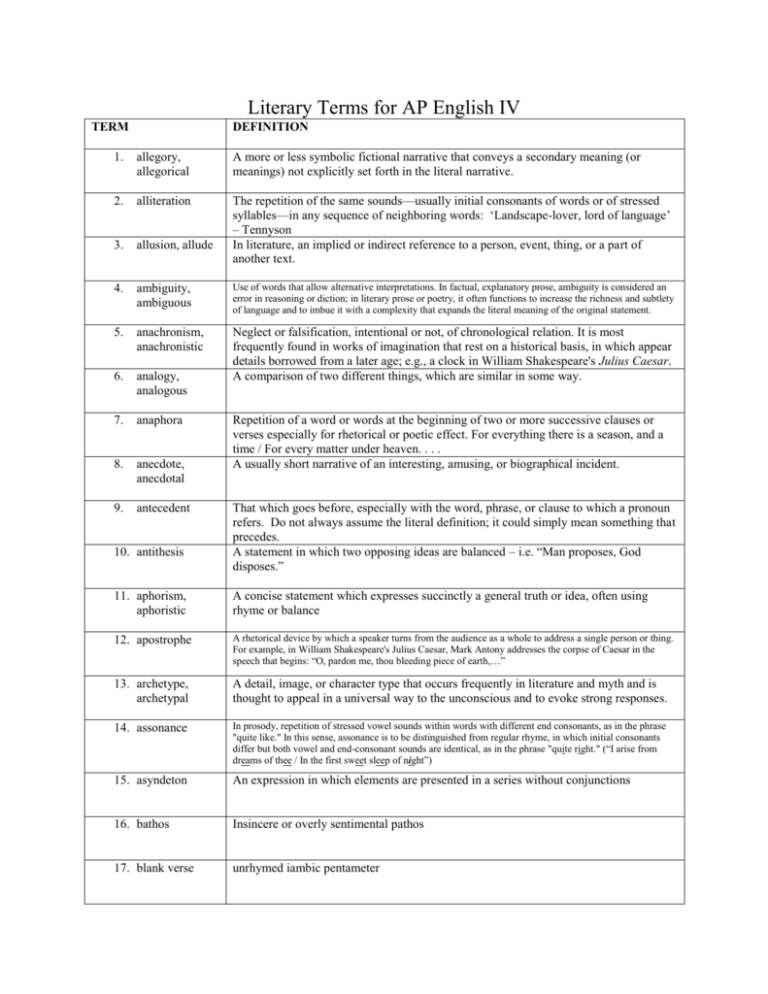
Literary Terms for AP English IV TERM DEFINITION 1. allegory, allegorical A more or less symbolic fictional narrative that conveys a secondary meaning (or meanings) not explicitly set forth in the literal narrative. 2. alliteration 3. allusion, allude The repetition of the same sounds—usually initial consonants of words or of stressed syllables—in any sequence of neighboring words: ‘Landscape-lover, lord of language’ – Tennyson In literature, an implied or indirect reference to a person, event, thing, or a part of another text. 4. ambiguity, ambiguous Use of words that allow alternative interpretations. In factual, explanatory prose, ambiguity is considered an error in reasoning or diction; in literary prose or poetry, it often functions to increase the richness and subtlety of language and to imbue it with a complexity that expands the literal meaning of the original statement. 5. anachronism, anachronistic 6. analogy, analogous Neglect or falsification, intentional or not, of chronological relation. It is most frequently found in works of imagination that rest on a historical basis, in which appear details borrowed from a later age; e.g., a clock in William Shakespeare's Julius Caesar. A comparison of two different things, which are similar in some way. 7. anaphora 8. anecdote, anecdotal 9. antecedent 10. antithesis Repetition of a word or words at the beginning of two or more successive clauses or verses especially for rhetorical or poetic effect. For everything there is a season, and a time / For every matter under heaven. . . . A usually short narrative of an interesting, amusing, or biographical incident. That which goes before, especially with the word, phrase, or clause to which a pronoun refers. Do not always assume the literal definition; it could simply mean something that precedes. A statement in which two opposing ideas are balanced – i.e. “Man proposes, God disposes.” 11. aphorism, aphoristic A concise statement which expresses succinctly a general truth or idea, often using rhyme or balance 12. apostrophe A rhetorical device by which a speaker turns from the audience as a whole to address a single person or thing. For example, in William Shakespeare's Julius Caesar, Mark Antony addresses the corpse of Caesar in the speech that begins: “O, pardon me, thou bleeding piece of earth,…” 13. archetype, archetypal A detail, image, or character type that occurs frequently in literature and myth and is thought to appeal in a universal way to the unconscious and to evoke strong responses. 14. assonance In prosody, repetition of stressed vowel sounds within words with different end consonants, as in the phrase "quite like." In this sense, assonance is to be distinguished from regular rhyme, in which initial consonants differ but both vowel and end-consonant sounds are identical, as in the phrase "quite right." (“I arise from dreams of thee / In the first sweet sleep of night”) 15. asyndeton An expression in which elements are presented in a series without conjunctions 16. bathos Insincere or overly sentimental pathos 17. blank verse unrhymed iambic pentameter 18. cacophony, cacophonous Harsh or discordant sound; specifically, harshness in the sound of words or phrases. It is opposite in meaning from euphony. Also called dissonance. 19. chiasmus A statement consisting of two parallel parts in which the second part is structurally reversed – i.e. “Flowers are lovely, love is flowerlike” 20. clause A group of words containing a subject and its verb that may or may not be a complete sentence. 21. cliché, clichéd A trite expression or idea. 22. colloquial Typical of or appropriate to the spoken language, informal, conversational; also vernacular. 23. conceit An unusual and surprising comparison between two very different things, which is then extended throughout the length of the piece of literature. 24. concrete poetry Poetry in which the poet's intent is conveyed by graphic patterns of letters, words, or symbols rather than by the meaning of words in conventional arrangement. 25. connotation, connotes An association that a word calls to mind in addition to its dictionary meaning 26. consonance Recurrence or repetition of identical or similar consonants; specifically, the correspondence of end or intermediate consonants unaccompanied by like correspondence of vowels at the ends of two or more syllables, words, or other units of composition. "The curfew tolls the knell of parting day" 27. convention A practice or procedure widely observed in a group. 28. denotation, denotes A word’s objective meaning, that to which the word refers, independent of other associations that the word calls to mind. 29. diction Choice of words, especially with regard to correctness, clearness, or effectiveness. Any of the four generally accepted levels of diction--formal, informal, colloquial, or slang--may be correct in a particular context but incorrect in another or when mixed unintentionally. Most ideas have a number of alternate words that the writer can select to suit a particular purpose. "Children," "kids," "youngsters," "youths," and "brats," for example, all have different evocative values. Also called didactical. Of literature or other art, intended to convey instruction and information. The word is often used to refer to texts that are overburdened with instructive or factual matter to the exclusion of graceful and pleasing detail so that they are pompously dull and erudite. 30. didactic 31. digression Straying from the main subject. 32. elegy, elegiac A song or poem expressing sorrow or lamentation, especially for one who is dead. 33. ellipsis The omission of one or more words that are understood but that must be supplied to make a construction semantically complete, as in "No! I am not Prince Hamlet, nor was meant to be" from T.S. Eliot's poem "The Love Song of J. Alfred Prufrock." In poetry , marked by a grammatical pause at the end of a line, as in these lines from Alexander Pope's An Essay on Criticism: A little learning is a dangerous thing; / Drink deep, or taste not the Pierian spring. The continuation of the sense and grammatical constructions of a line on to the next verse or couplet. 34. end-stopped 35. enjambment, enjambed 36. epigram, epigramic A short poem treating concisely, pointedly, and often satirically a single thought or event and often ending with a witticism or ingenious turn of thought. By extension the term is also applied to a terse, sage, or witty, often paradoxical saying, usually in the form of a generalization. -- What is an epigram? a dwarfish whole, Its body brevity, and wit its soul. –Samuel Taylor Coleridge 37. epigraph A quotation that appears at the beginning of a literary work that introduces a motif or theme that is developed in the work itself. 38. Epiphany, epiphanal A moment of sudden revelation 39. euphemism, euphemistic A figure of speech using indirection to avoid offensive bluntness. 40. euphony, euphonious Pleasing, harmonious, or sweet sound, the acoustic effect produced by words so formed and combined as to please the ear. 41. figurative language Of language or writing, characterized by figures of speech (such as metaphor and simile) or elaborate expression, as opposed to literal language. 42. figure of speech A form of expression used to convey meaning or heighten effect, often by comparing or identifying one thing with another that has a meaning or connotation familiar to the reader or listener. A section of a literary work that interrupts the sequence of events to relate an event from an earlier time. 43. flashback 44. foil, foils 45. Foot, feet 46. free verse 47. gerund Literally, a “leaf” of bright metal placed under a jewel to increase its brilliance. The term is applied to any character who through contrast underscores the distinctive characteristics of another. Thus, Laertes, Fortinbras, and the Players—all of whom are willing and able to take action with less reason than Hamlet has—serve as foils to Hamlet. In poetry , the basic unit of verse meter consisting of any of various fixed combinations or groups of stressed and unstressed or long and short syllables. iamb, an unstressed followed by a stressed syllable re | port; trochee, a stressed followed by an unstressed syllable, dai | ly; anapest, two unstressed syllables followed by a stressed syllable, ser | e | nade; dactyl, a stressed syllable followed by two unstressed syllables, mer | ri | ly. Poetry organized to the cadences of speech and image patterns rather than according to a regular metrical scheme. Its rhythms are based on patterned elements such as sounds, words, phrases, sentences, and paragraphs, rather than on the traditional prosodic units of feet per Themetrical “ing” form of aline. verb, i.e. running 48. grotesque A decorative style in which animal, human, and vegetative forms are interwoven and deformed to the point of absurdity. 49. heroic couplet A couplet of rhyming iambic pentameters often forming a distinct rhetorical as well as metrical unit. Then share thy pain, allow that sad relief; / Ah, more than share it, give me all thy grief. A figure of speech that is an intentional exaggeration for emphasis or comic effect 50. hyperbole, hyperbolic 51. imagery, image, imagistic Representation of objects, feelings, or ideas, either literally or through the use of figurative language; specifically, the often peculiarly individual concrete or figurative diction used by a writer in those portions of text where a particular effect (such as a special emotional appeal or a train of intellectual associations) is desired. 52. imperative The mood of a verb that gives an order. “Eat your vegetables” uses an imperative verb. 53. inference, infer Deriving a conclusion from facts or circumstances 54. irony, ironic The use of words to express something other than and especially the opposite of the literal meaning (as when expressions of praise are used where blame is meant). 55. jargon The special language of a profession or group. The term jargon usually has pejorative associations, with the implication that jargon is evasive, tedious, and unintelligible to outsiders. The writings of the lawyer and the literary critic are both susceptible to jargon. 56. Juxtaposition, juxtapose To place side by side, especially for contrast and comparison. 57. litotes A figure of speech by which conscious understatement is used to create emphasis by negation; examples are the expressions "not bad!" and "no mean feat." 58. malapropism A mistaken substitution of one word for another, which sounds similar (The doctor wrote a subscription.) 59. metaphor A figure of speech in which a word or phrase denoting one kind of object or action is used in place of another to suggest a likeness or analogy between them (as in the ship plows the seas or in a volley of oaths). A metaphor is an implied comparison (as in a marble brow) in contrast to the explicit comparison of the simile (as in a brow white as marble). 60. meter Systematically arranged and measured rhythm in verse 61. metonymy, metonymic Figure of speech that consists of using the name of one thing for something else with which it is associated (as in "I spent the evening reading Shakespeare" or "lands belonging to the crown" or "demanding action by city hall"). One syllable 62. monosyllabic, monosyllable 63. narrative techniques 64. onomatopoeia, onomatopoeic The methods involved in telling a story; the procedures used by a writer of stories or accounts. Examples of the techniques would be point of view, manipulation of time, or interior monologue. The naming of a thing or action by a vocal imitation of the sound associated with it (such as buzz or hiss). The use of words whose sound suggests the sense. 65. oxymoron, oxymoronic A word or group of words that is self-contradicting, as in bittersweet or plastic glass. 66. paradox, paradoxical A tenet or proposition contrary to received opinion. An apparently self-contradictory statement, the underlying meaning of which is revealed only by careful scrutiny. The purpose of a paradox is to arrest attention and provoke fresh thought. The statement "Less is more" is an example. 67. parallel structure in meaning: " a component of literary style in both prose and poetry, in which coordinate ideas are arranged in phrases, sentences, and paragraphs that balance one element with another of equal importance and similar wording. The repetition of sounds, meanings, and structures serves to order, emphasize, and point out relations. In its simplest form parallelism may consist of a pair of single words that are synonymous or have a slight variation ordain and establish" or "overtake and surpass." Another variety contains three or more parallel units as in "Reading maketh a full man, conference a ready man, and writing an exact man" 68. parody A literary work in which the style of an author is closely imitated for comic effect or in ridicule. 69. pathos An element in artistic representation evoking pity or compassion. 70. persona In literature, the person who is understood to be speaking (or thinking or writing) a particular work. The persona is almost invariably distinct from the author; it is the voice chosen by the author for a particular artistic purpose. The persona may be a character in the work in question or merely an unnamed narrator, but, insofar as the manner and style of expression in the work exhibit taste, prejudice, emotion, or other characteristics of a human personality, the work may be said to be in the voice of a persona 71. personification Figure of speech in which human characteristics are attributed to an abstract quality, animal, or inanimate object. 72. point of view The perspective from which a story is presented to the reader. The three main points of view are first person, third person singular, and third person omniscient. 73. Polysyllabic, polysyllable More than one syllable 74. polysyndeton The use of more conjunctions than is necessary or natural for rhetorical effect 75. pun A humorous use of a word in such a way as to suggest different meanings or applications, or a play on words 76. reverie Abstracted musing, daydreaming 77. rhetoric The art of speaking or writing effectively; the study of writing or speaking as a means of communication or persuasion; skill in the effective use of speech; a type or mode of language or speech; insincere or grandiloquent language 78. rhetorical question A question to which no answer is expected. 79. rhetorical strategy The management of language for a specific effect. 80. rhetorical techniques The devices used in effective or persuasive language. The most common examples are contrast, repetitions, paradox, understatement, sarcasm, and rhetorical question. 81. rhyme Identity of terminal sound between accented syllables, usually occupying corresponding positions in two or more lines of verse. There are many different types of rhyme. Some are: end rhyme, internal rhyme, beginning rhyme, masculine rhyme, feminine rhyme, slant rhyme, etc. 82. rhyme scheme The pattern in which rhyme sounds occur in a stanza. 83. satire, satiric, satirical A usually topical literary composition holding up human or individual vices, folly, abuses, or shortcomings to censure by means of ridicule, derision, burlesque, irony, or other methods, sometimes with an intent to bring about improvement. The background to a story; the physical location of a play, story, or novel. 84. setting 85. simile Figure of speech involving a comparison between two unlike entities. In the simile, unlike the metaphor, the resemblance is explicitly indicated by the words "like" or "as." 86. sonnet A fixed verse form of Italian origin consisting of 14 lines that are typically five-foot iambs rhyming according to a prescribed scheme 87. speaker The imaginary voice assumed by the writer of a poem. 88. stanza A division of a poem consisting of two or more lines arranged together as a unit. More specifically, a stanza usually is a group of lines arranged together in a recurring pattern of metrical lengths and a sequence of rhymes. Narrative technique in non-dramatic fiction intended to render the flow of myriad impressions--visual, auditory, physical, associative, and subliminal--that together with rational thought impinge on the consciousness of an individual. 89. stream of consciousness 90. structure The arrangement of materials within a work; the relationship of the parts of a work to the whole; the logical divisions of a work. 91. style The mode of expression of language; the characteristic manner of expression of an author. 92. syllogism Deductive reasoning consisting of a major premise, a minor premise, and a conclusion. Also deduction 93. symbol Something that stands for or suggests something else by reason of relationship, association, convention, or accidental resemblance; especially, a visible sign of something invisible (for example, the lion is a symbol of courage and the cross is a symbol of Christianity). 94. synesthesia Describing one kind of sensation in terms of another (“a loud color,” “a sweet sound”) 95. synecdoche, 97. theme, thematic Figure of speech in which a part represents the whole, as in the expression "hired hands" for workmen or, less commonly, the whole represents a part, as in the use of the word "society" to mean high society wholeofrepresents as in the useofofwords the word high of The 82. structure a sentence;a part, the arrangement in a "society" sentence. toAmean discussion society. syntax could include length or brevity of a sentence and kinds of sentences, like questions, exclamations, declarative, rhetorical, etc. The dominant idea of a work of literature. 98. tone The attitude of the author towards his or her work and or audience. 99. understatement To represent as less than is the case. To state or present with restraint, especially for effect. 100. zeugma From the Greek verb “yoke,” a figure of speech in which one word governs (yokes) a series of succeeding words or phrases. Example from Shakespeare: “Give them thy fingers, me thy lips to kiss.” The verb “give” governs the two phrases that follow. 96. syntax, syntactic Assignment: Illustrate your assigned literary term for the class. Illustration should be on construction paper or poster 8 ½” x 11” If necessary, use glue NOT tape Be prepared to present to the class on August 19 or 20, 2014 Text to Include: Term Pronunciation Part of Speech Can include an interesting way to remember the term (but no definitions) Illustrations: Try to illustrate at least the primary meaning of the term You may use original artwork, clipart, photos, or magazine clippings Be creative – do not merely Google something and print the illustration already accompanying it. Have some fun and stretch your literary vocabulary at the same time.
